Secure Energy Efficiency Maximization for IRS-Assisted UAV Communication: Joint Beamforming Design and Trajectory Optimization
Abstract
Highlights
- An optimization algorithm is developed to enhance the security and energy efficiency of IRS–UAV communication by jointly optimizing active beamforming, IRS phase shift, and UAV trajectory.
- The Riemannian manifold optimization approach reduces the computational complexity of solving for IRS phase shifts.
- The proposed algorithm offers theoretical support for efficient UAV communication deployment in highly obstructed urban environments.
- It provides a practical solution for achieving secure and energy-efficient aerial communications in complex scenarios.
Abstract
1. Introduction
- We propose an IRS-assisted UAV communication system for city environments with high occlusion while countering an eavesdropper. The direct link between the UAV and the base station is interrupted due to obstruction by a high-rise building. The IRS is deployed to reflect the UAV signal to the base station. Then, we demonstrate a system communication channel model and formulate a secure energy efficiency problem.
- The secure energy efficiency optimization problem is solved by jointly optimizing UAV active beamforming, IRS passive beamforming, and UAV trajectory. In addition, for the IRS passive beamforming optimization, we propose a Riemannian-manifold-based optimization algorithm to reduce computational complexity. Subsequently, by using successive convex approximation (SCA) and the Dinkelbach algorithm, the UAV trajectory optimization problem is solved.
- Simulation results demonstrate the effectiveness of the proposed model and algorithm. We set up two comparison schemes: one without an IRS and one with a random phase shift. The simulation results show that the performance of the proposed model and algorithm is superior to the above two schemes, thus verifying the importance of deploying IRSs and dynamically optimizing passive beamforming.
2. System Model and Problem Formulation
2.1. System Model
2.2. Problem Formulation
3. Problem Solution
3.1. UAV Active Beamforming Optimization
3.2. IRS Phase Shift Optimization
| Algorithm 1 IRS phase shift optimization based on Riemannian manifold |
| Input: Active beamforming vector, UAV trajectory, iteration k = 0; |
| 1. Initialize search direction: ; 2. Repeat: 3. Compute tangent space update via Equation (37); 4. Apply retraction update via Equation (38); 5. Update search direction via Equation (36); 6. ; 7. Until it converges within the threshold; 8. Output: IRS phase shift matrix. |
3.3. UAV Trajectory Optimization
3.4. Overall Algorithm Analysis
| Algorithm 2 The proposed algorithm of joint beamforming and UAV trajectory optimization |
| Input: Active beamforming vector , IRS phase shift matrix , UAV trajectory , set iteration r = 0, convergence threshold = 0; Begin: |
| 1. While objective improvement > do: 2. Given and , obtain via Section 3.1; 3. While inner loop not converged do: 4. Given and , obtain via Section 3.2; 5. End While 6. While inner loop not converged do: 7. Given and , obtain via Section 3.3; 8. End While 9. Update 10. Until it converges within the threshold. 11. End While End Output: Optimized active beamforming vector , , |
4. Simulation Result
5. Conclusions
Author Contributions
Funding
Data Availability Statement
Conflicts of Interest
References
- Saad, W.; Bennis, M.; Chen, M. A Vision of 6G Wireless Systems: Applications, Trends, Technologies, and Open Research Problems. IEEE Netw. 2020, 34, 134–142. [Google Scholar] [CrossRef]
- Ahokangas, P.; Matinmikko-Blue, M.; Yrjölä, S. Envisioning a Future-Proof Global 6G from Business, Regulation, and Technology Perspectives. IEEE Commun. Mag. 2023, 61, 72–78. [Google Scholar] [CrossRef]
- Mozaffari, M.; Saad, W.; Bennis, M.; Nam, Y.H.; Debbah, M. A Tutorial on UAVs for Wireless Networks: Applications, Challenges, and Open Problems. IEEE Commun. Surv. Tutor. 2019, 21, 2334–2360. [Google Scholar] [CrossRef]
- Chen, X.; Sheng, M.; Li, B.; Zhao, N. Survey on Unmanned Aerial Vehicle Communications for 6G. J. Electron. Inf. Technol. 2022, 44, 781–789. [Google Scholar]
- Tang, X.; Chen, F.; Wang, F.; Jia, Z. Disaster-Resilient Emergency Communication with Intelligent Air–Ground Cooperation. IEEE Internet Things J. 2024, 11, 5331–5346. [Google Scholar] [CrossRef]
- Dicandia, F.A.; Fonseca, N.J.G.; Bacco, M.; Mugnaini, S.; Genovesi, S. Space-Air-Ground Integrated 6G Wireless Communication Networks: A Review of Antenna Technologies and Application Scenarios. Sensors 2022, 22, 3136. [Google Scholar] [CrossRef]
- Zhang, P.; Chen, S.; Zheng, X.; Li, P.; Wang, G.; Wang, R.; Wang, J.; Tan, L. UAV Communication in Space–Air–Ground Integrated Networks (SAGINs): Technologies, Applications, and Challenges. Drones 2025, 9, 108. [Google Scholar] [CrossRef]
- Wu, M.; Xiao, Y.; Gao, Y.; Xiao, M. Digital Twin for UAV-RIS Assisted Vehicular Communication Systems. IEEE Trans. Wirel. Commun. 2024, 23, 7638–7651. [Google Scholar] [CrossRef]
- Murroni, I.; Anedda, M.; Fadda, M.; Ruiu, P.; Popescu, V.; Zaharia, C.; Giusto, D. 6G—Enabling the New Smart City: A Survey. Sensors 2023, 23, 7528. [Google Scholar] [CrossRef]
- Yan, C.; Fu, L.; Zhang, J.; Wang, J. A Comprehensive Survey on UAV Communication Channel Modeling. IEEE Access 2019, 7, 107769–107792. [Google Scholar] [CrossRef]
- Hamid, H.; Begh, G.R. IRS assisted UAV communications for 6G networks: A systematic literature review. Wirel. Netw. 2025, 31, 779–807. [Google Scholar] [CrossRef]
- Jiao, S.; Fang, F.; Zhou, X.; Zhang, H. Joint Beamforming and Phase Shift Design in Downlink UAV Networks with IRS-Assisted NOMA. J. Commun. Inf. Netw. 2020, 5, 138–149. [Google Scholar] [CrossRef]
- Hua, M.; Yang, L.; Wu, Q.; Pan, C.; Li, C.; Swindlehurst, A.L. UAV-Assisted Intelligent Reflecting Surface Symbiotic Radio System. IEEE Trans. Wirel. Commun. 2021, 20, 5769–5785. [Google Scholar] [CrossRef]
- Li, S.; Yuan, X.; Liang, Y.C.; Renzo, D.M. Reconfigurable Intelligent Surface Assisted UAV Communication: Joint Trajectory Design and Passive Beamforming. IEEE Wirel. Commun. Lett. 2023, 17, 3670–3681. [Google Scholar] [CrossRef]
- Ji, Z.; Yang, W.; Guan, X.; Zhao, X.; Li, G.; Wu, Q. Trajectory and Transmit Power Optimization for IRS-Assisted UAV Communication Under Malicious Jamming. IEEE Trans. Veh. Technol. 2022, 71, 11262–11266. [Google Scholar] [CrossRef]
- Pang, X.; Zhao, N.; Tang, J.; Wu, C.; Niyato, D.; Wong, K.K. IRS-Assisted Secure UAV Transmission via Joint Trajectory and Beamforming Design. IEEE Trans. Commun. 2022, 70, 1140–1152. [Google Scholar] [CrossRef]
- Xu, B.; Hu, L.; Wei, S.; Qian, Y.; Yan, S.; Shu, F.; Li, J. On IRS-Assisted Covert Communication with a Friendly UAV. Drones 2023, 7, 453. [Google Scholar] [CrossRef]
- Fang, S.; Chen, G.; Li, Y. Joint Optimization for Secure Intelligent Reflecting Surface Assisted UAV Networks. IEEE Wirel. Commun. Lett. 2021, 10, 276–280. [Google Scholar] [CrossRef]
- Alsarayreh, A.S.; Radzi, M.A.N.; Alkahtani, A.A.; Azmi, M.H.K. Intelligent Reflecting Surface–UAV Systems in the Internet of Things Network: A Survey. IEEE Acess 2023, 11, 85031–85049. [Google Scholar] [CrossRef]
- Su, Y.; Pang, X.; Chen, S.; Jiang, X.; Zhao, N.; Yu, F.R. Spectrum and Energy Efficiency Optimization in IRS-Assisted UAV Networks. IEEE Trans. Commun. 2022, 70, 6489–6502. [Google Scholar] [CrossRef]
- Zhao, H.; Hao, J.; Guo, Y. Joint Trajectory and Beamforming Design for IRS-assisted Anti-jamming UAV Communication. In Proceedings of the 2022 IEEE Wireless Communications and Networking Conference 2022, Austin, TX, USA, 10–13 April 2022. [Google Scholar]
- Wu, Q.; Zhang, R. Towards Smart and Reconfigurable Environment: Intelligent Reflecting Surface Aided Wireless Network. IEEE Commun. Mag. 2020, 18, 106–112. [Google Scholar] [CrossRef]
- Wu, Q.; Zhang, R. Intelligent Reflecting Surface Enhanced Wireless Network via Joint Active and Passive Beamforming. IEEE Trans. Wirel. Commun. 2019, 18, 5394–5409. [Google Scholar] [CrossRef]
- Zeng, Y.; Zhang, R. Energy-Efficient UAV Communication with Trajectory Optimization. IEEE Trans. Wirel. Commun. 2017, 16, 3747–3760. [Google Scholar] [CrossRef]
- Gopala, K.P.; Lai, L.; Gamal, E.H. On the Secrecy Capacity of Fading Channels. IEEE Trans. Inf. Theory 2008, 54, 4687–4689. [Google Scholar] [CrossRef]
- Li, Q.; Ma, W.K. Optimal and Robust Transmit Designs for MISO Channel Secrecy by Semidefinite Programming. IEEE Trans. Signal Process. 2011, 59, 3799–3812. [Google Scholar] [CrossRef]
- Yuan, G.; Wei, Z.; Li, G. A Modified Polak–Ribière–Polyak Conjugate Gradient Algorithm for Nonsmooth Convex Programs. J. Comput. Appl. Math. 2014, 255, 86–96. [Google Scholar] [CrossRef]
- Huang, W.; Absil, A.P.; Gallivan, A.K. A Riemannian BFGS Method Without Differentiated Retraction for Nonconvex Optimization Problems. SIAM J. Optim. 2018, 28, 470–495. [Google Scholar] [CrossRef]
- Chen, H.J.; Schaible, S.; Sheu, R.L. Generic Algorithm for Generalized Fractional Programming. J. Optim. Theory Appl. 2008, 141, 93–105. [Google Scholar] [CrossRef]
- Yu, Y.; Liu, X.; Liu, Z.; Durrani, T.S. Joint Trajectory and Resource Optimization for RIS Assisted UAV Cognitive Radio. IEEE Trans. Veh. Technol. 2023, 72, 13643–13648. [Google Scholar] [CrossRef]


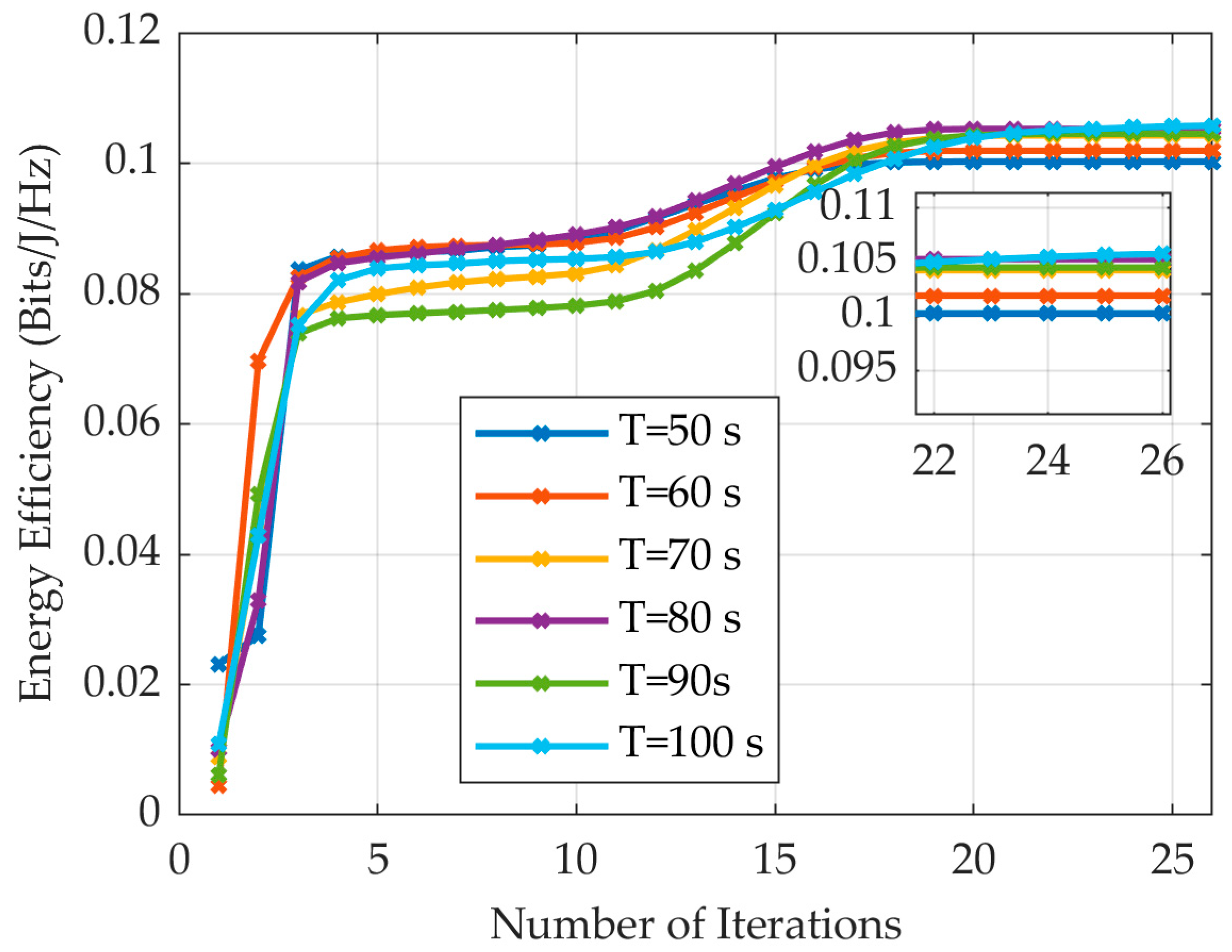
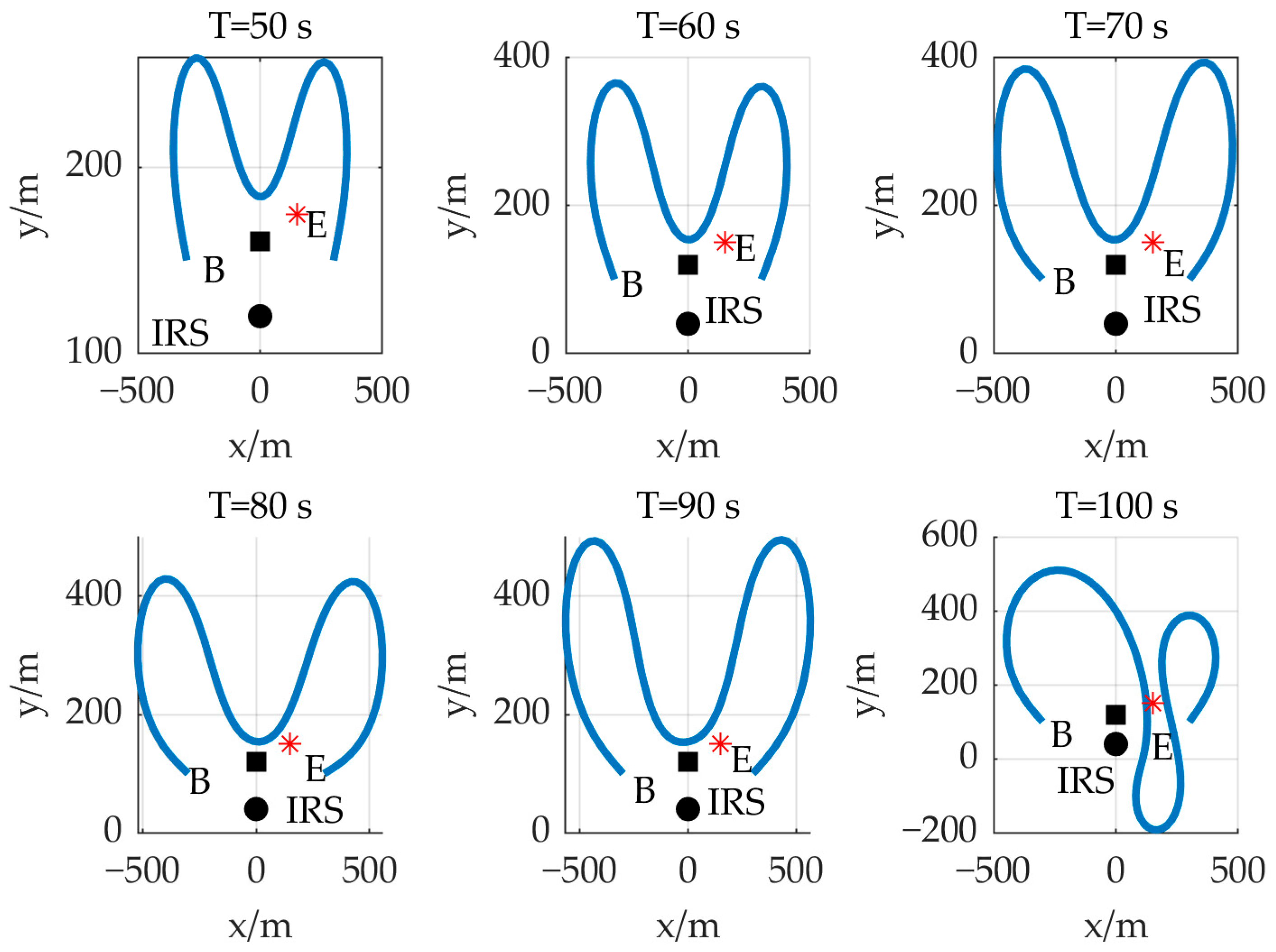
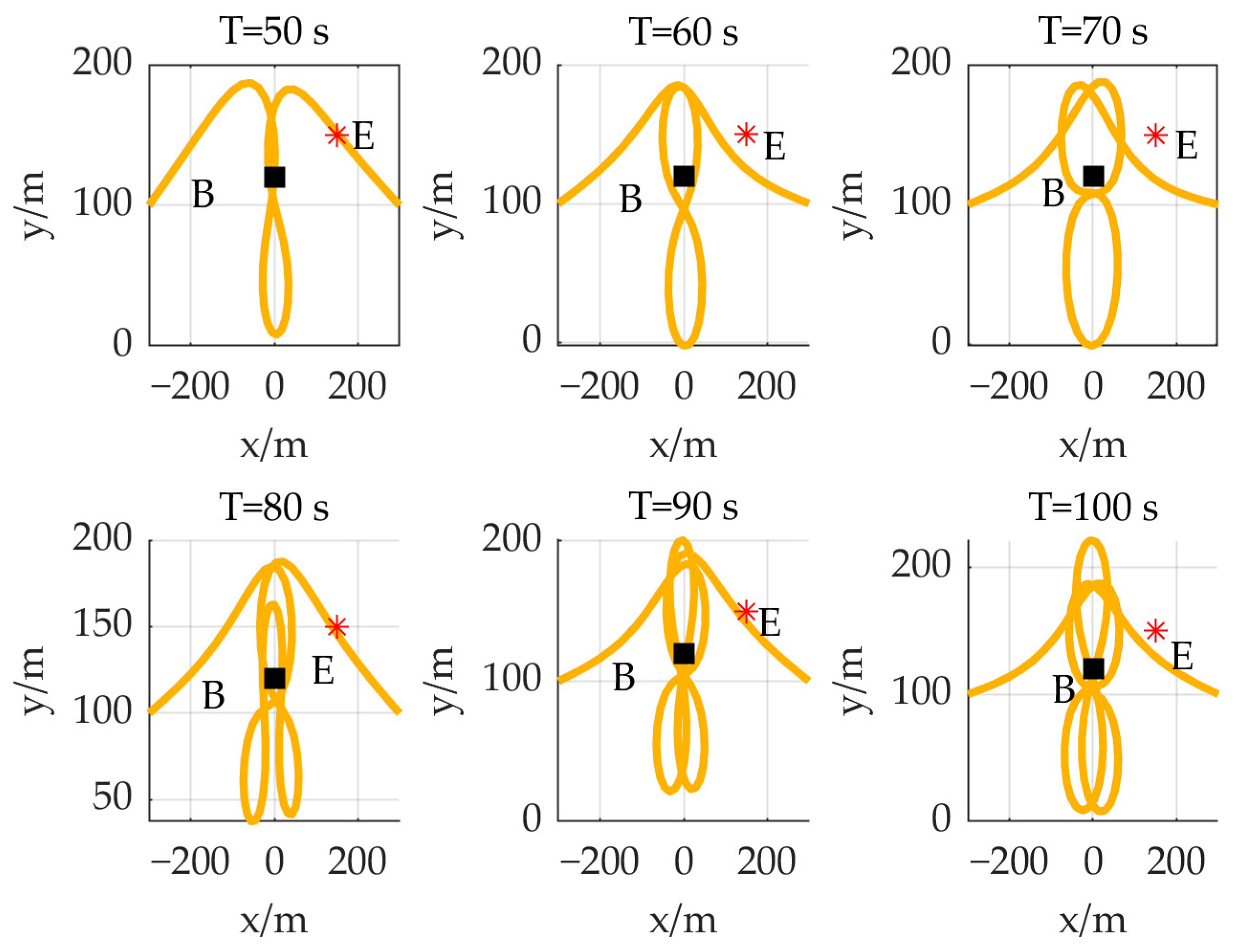


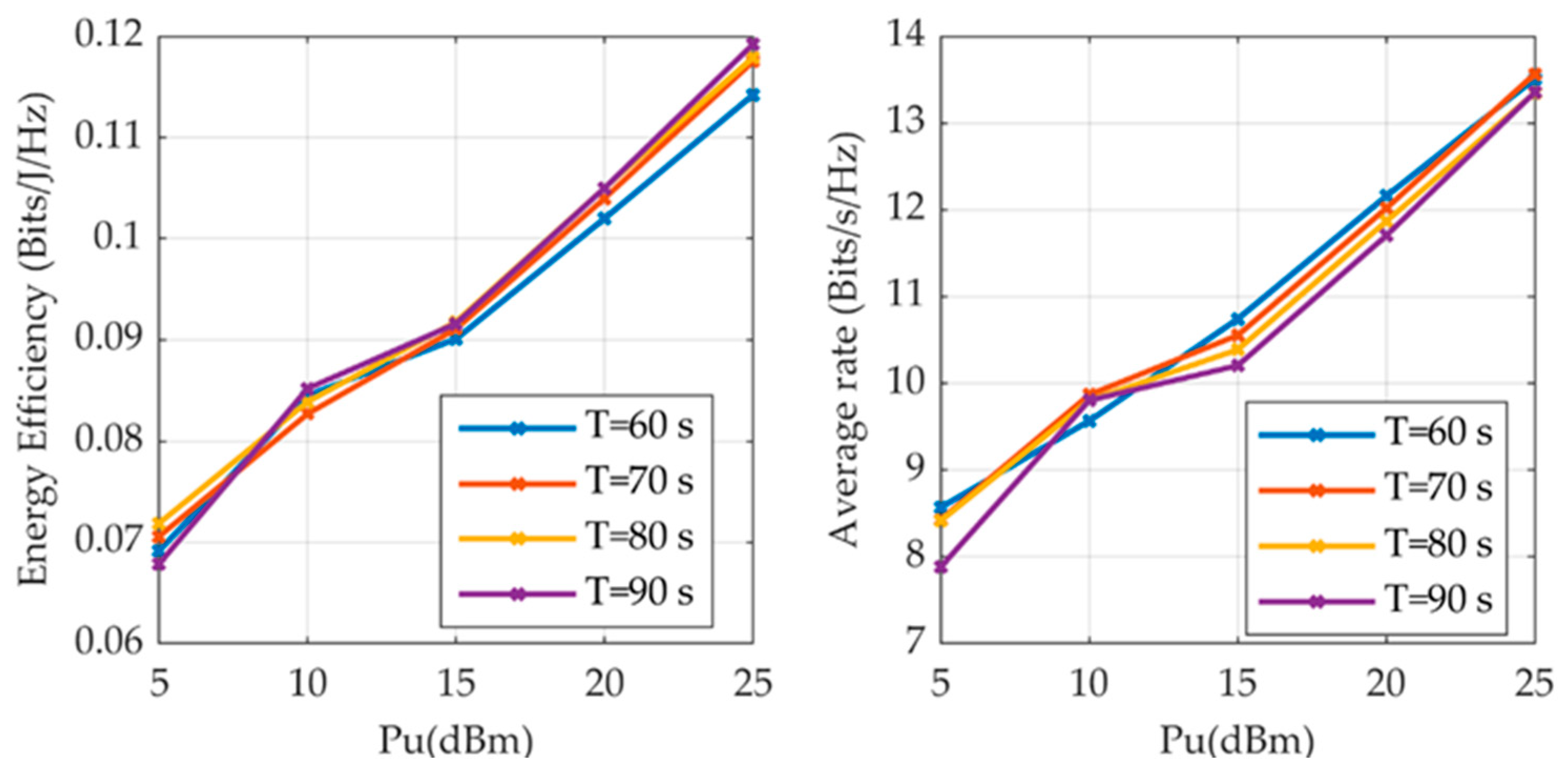
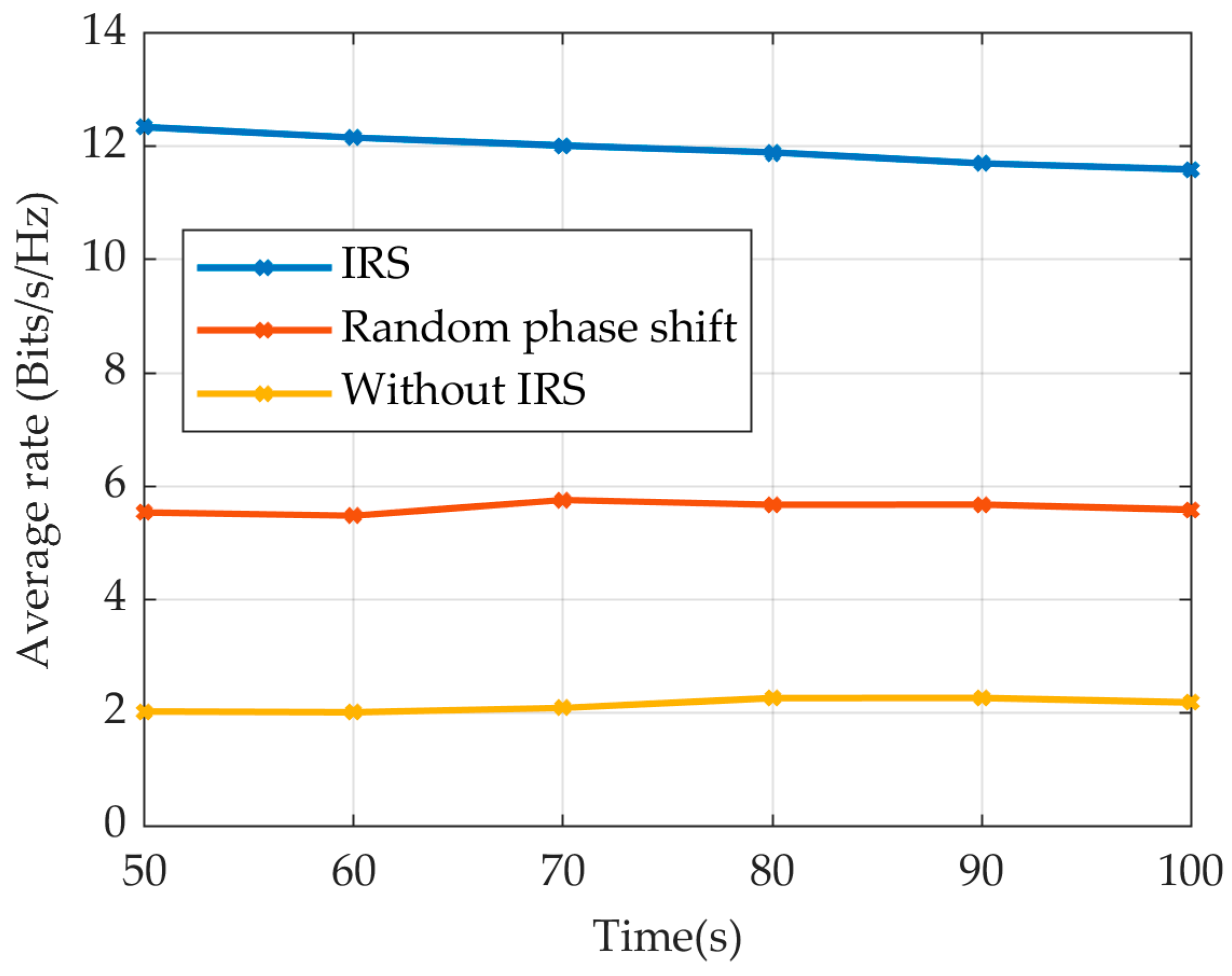
| Simulation Parameter | Physical Meaning | Value |
|---|---|---|
| UAV altitude | 100 m | |
| IRS altitude | 30 m | |
| Number of UAV antennas | 8 | |
| IRS reflection unit number | 8 | |
| UAV maximum velocity | 50 m/s | |
| UAV maximum acceleration | 5 m/s2 | |
| Channel power gain | −30 dB | |
| Noise power | −60 dBm | |
| Path loss exponent | 2.2 | |
| Rician factor | K | 5 |
| UAV maximum power | 20 dBm | |
| Threshold |
| IRS y-Coordinate (m) | Energy Efficiency (Bits/J/Hz) | Average Rate (Bits/s/Hz) |
|---|---|---|
| 50 | 0.1067 | 11.8643 |
| 70 | 0.1128 | 12.9223 |
| 90 | 0.1152 | 13.2201 |
| 110 | 0.1144 | 13.1315 |
| 130 | 0.1142 | 13.1116 |
| 150 | 0.1045 | 11.8864 |
| Time(s) | IRS | Without IRS | Random Phase Shift |
|---|---|---|---|
| 50 | 0.0921 | 0.0131 | 0.0449 |
| 60 | 0.102 | 0.0132 | 0.0444 |
| 70 | 0.104 | 0.0136 | 0.0450 |
| 80 | 0.105 | 0.0128 | 0.0423 |
| 90 | 0.105 | 0.0132 | 0.0486 |
| 100 | 0.0909 | 0.0136 | 0.0470 |
Disclaimer/Publisher’s Note: The statements, opinions and data contained in all publications are solely those of the individual author(s) and contributor(s) and not of MDPI and/or the editor(s). MDPI and/or the editor(s) disclaim responsibility for any injury to people or property resulting from any ideas, methods, instructions or products referred to in the content. |
© 2025 by the authors. Licensee MDPI, Basel, Switzerland. This article is an open access article distributed under the terms and conditions of the Creative Commons Attribution (CC BY) license (https://creativecommons.org/licenses/by/4.0/).
Share and Cite
Lv, J.; Cheng, J.; Li, P. Secure Energy Efficiency Maximization for IRS-Assisted UAV Communication: Joint Beamforming Design and Trajectory Optimization. Drones 2025, 9, 648. https://doi.org/10.3390/drones9090648
Lv J, Cheng J, Li P. Secure Energy Efficiency Maximization for IRS-Assisted UAV Communication: Joint Beamforming Design and Trajectory Optimization. Drones. 2025; 9(9):648. https://doi.org/10.3390/drones9090648
Chicago/Turabian StyleLv, Jiazheng, Jianhua Cheng, and Peng Li. 2025. "Secure Energy Efficiency Maximization for IRS-Assisted UAV Communication: Joint Beamforming Design and Trajectory Optimization" Drones 9, no. 9: 648. https://doi.org/10.3390/drones9090648
APA StyleLv, J., Cheng, J., & Li, P. (2025). Secure Energy Efficiency Maximization for IRS-Assisted UAV Communication: Joint Beamforming Design and Trajectory Optimization. Drones, 9(9), 648. https://doi.org/10.3390/drones9090648






